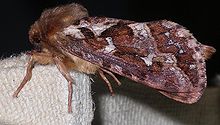Pharmacis fusconebulosa
| Map-winged swift | |
|---|---|
 |
|
| Scientific classification | |
| Kingdom: | Animalia |
| Phylum: | Arthropoda |
| Class: | Insecta |
| Order: | Lepidoptera |
| Family: | Hepialidae |
| Genus: | Pharmacis |
| Species: | P. fusconebulosa |
| Binomial name | |
|
Pharmacis fusconebulosa (De Geer, 1778) |
|
| Synonyms | |
|
|
The map-winged swift (Pharmacis fusconebulosa) is a moth belonging to the family Hepialidae. It has a patchy distribution throughout Eurasia. It was previously placed in the genus Hepialus and some references still place it there.
This moth gets its common name from the variegated pattern of the forewing, in various shades of black, brown and white, which look rather like a map (although there are plainer forms). Unlike most hepialids, the pattern is rather similar in both sexes although the female is usually rather larger with a wingspan of up to 50 mm.
The adult flies from May to July (August in the north of the range) and is attracted to light, sometimes strongly so. This species overwinters twice as a larva.
This moth is strongly associated with bracken (Pteridium spp) and it is most frequently encountered in habitats where this plant occurs (e.g. moorland, heathland, open woodland). However the larva, which is a root-feeder, has been recorded on other ferns such as Polystichum, grasses such as red fescue and also on potatoes and probably will feed on a wide range of other plants.
...
Wikipedia
